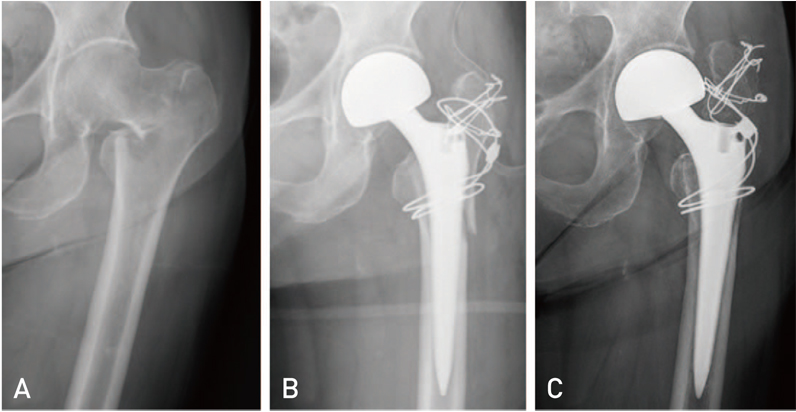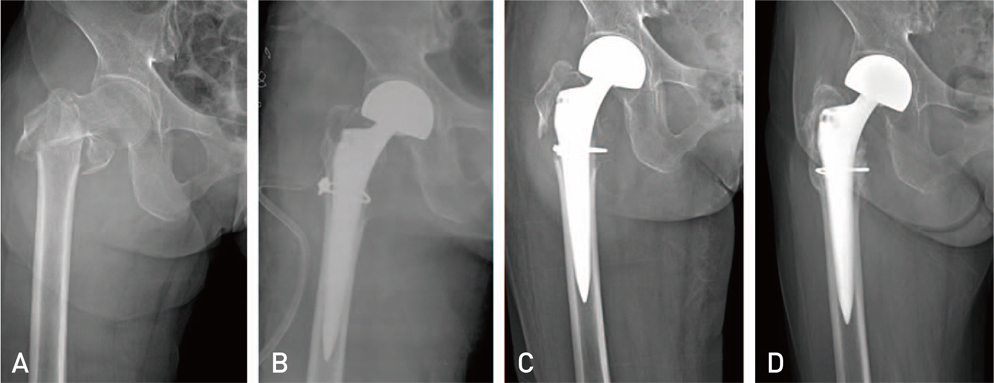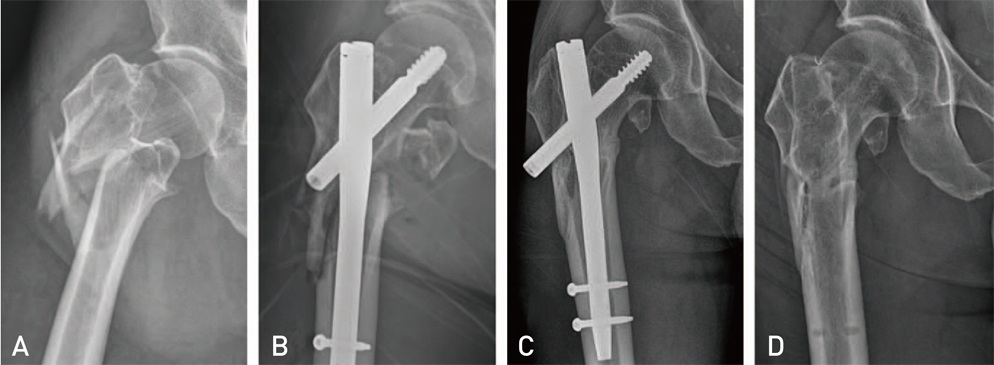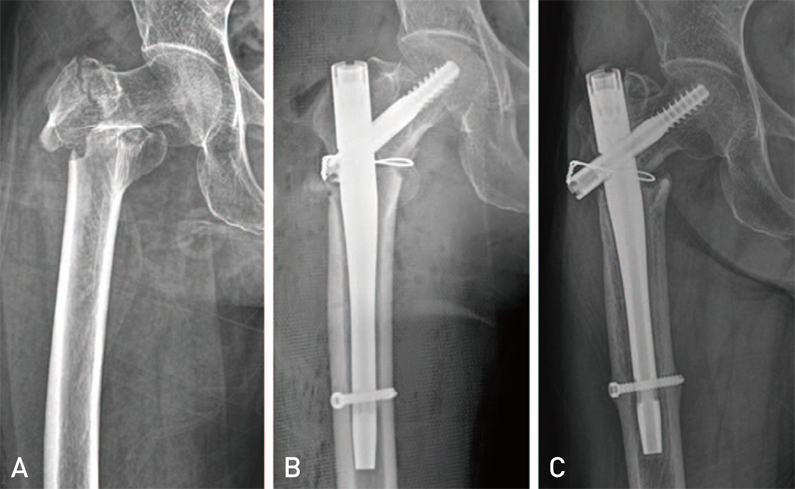Hip Pelvis.
2015 Sep;27(3):152-163. 10.5371/hp.2015.27.3.152.
A Comparison of Internal Fixation and Bipolar Hemiarthroplasty for the Treatment of Reverse Oblique Intertrochanteric Femoral Fractures in Elderly Patients
- Affiliations
-
- 1Department of Orthopedic Surgery, Gwangju Veterans Hospital, Gwangju, Korea. chm1228@hanmail.net
- KMID: 2069145
- DOI: http://doi.org/10.5371/hp.2015.27.3.152
Abstract
- PURPOSE
To compare the clinical and radiological results between internal fixation using the proximal femoral nail system and bipolar hemiarthroplasty (BHA) in reverse oblique intertrochanteric hip fractures in elderly patients.
MATERIALS AND METHODS
From January 2005 to July 2012, we reviewed the medical records of 53 patients who had been treated surgically for reverse oblique intertrochanteric fracture and had been followed-up on for a minimum of two years. All patients were > or =70 years of age, and divided into two groups for retrospective evaluation. One group was treated with internal fixation using the proximal femoral nail system (31 cases), and the other group was treated with BHA (22 cases).
RESULTS
Early ambulation postoperatively and less pain at postoperative three month were significantly superior in the BHA group. However, by 24 months postoperatively, the internal fixation group exhibited higher Harris scores and correspondingly less pain than the BHA group. There were no significant differences in union rate, duration of hospitalization or lateral wall fracture healing between the two groups. Four patients in the internal fixation group underwent reoperation.
CONCLUSION
In the treatment of intertrochanteric fracture of the reverse oblique type, open reduction and internal fixation should be considered to be the better choice for patients with good health and bone quality. However, in cases of severe comminition of fracture and poor bone quality, BHA is an alternative offering advantages including early ambulation, less pain at early stages, and a lower risk of reoperation.
MeSH Terms
Figure
Cited by 2 articles
-
Comparison between Cementless and Cemented Bipolar Hemiarthroplasty for Treatment of Unstable Intertrochanteric Fractures: Systematic Review and Meta-analysis
Jun-Il Yoo, Yong-Han Cha, Kap-Jung Kim, Ha-Yong Kim, Won-Sik Choy, Sun-Chul Hwang
Hip Pelvis. 2018;30(4):241-253. doi: 10.5371/hp.2018.30.4.241.Selecting Arthroplasty Fixation Approach Based on Greater Trochanter Fracture Type in Unstable Intertrochanteric Fractures
Min-Wook Kim, Young-Yool Chung, Sung-an Lim, Seung-Woo Shim
Hip Pelvis. 2019;31(3):144-149. doi: 10.5371/hp.2019.31.3.144.
Reference
-
1. Marsh JL, Slongo TF, Agel J, et al. Fracture and dislocation classification compendium - 2007: Orthopaedic Trauma Association classification, database and outcomes committee. J Orthop Trauma. 2007; 21:10 Suppl. S1–S133.2. Brammar TJ, Kendrew J, Khan RJ, Parker MJ. Reverse obliquity and transverse fractures of the trochanteric region of the femur; a review of 101 cases. Injury. 2005; 36:851–857.
Article3. Park MS, Cho HM, Kim JH, Shin WJ. Cementless bipolar hemiarthroplasty using a rectangular cross-section stem for unstable intertrochanteric fractures. Hip Int. 2013; 23:316–322.
Article4. Grimsrud C, Monzon RJ, Richman J, Ries MD. Cemented hip arthroplasty with a novel cerclage cable technique for unstable intertrochanteric hip fractures. J Arthroplasty. 2005; 20:337–343.
Article5. Haidukewych GJ, Israel TA, Berry DJ. Reverse obliquity fractures of the intertrochanteric region of the femur. J Bone Joint Surg Am. 2001; 83-A:643–650.
Article6. Willoughby R. Dynamic hip screw in the management of reverse obliquity intertrochanteric neck of femur fractures. Injury. 2005; 36:105–109.
Article7. Ozkan K, Eceviz E, Unay K, Tasyikan L, Akman B, Eren A. Treatment of reverse oblique trochanteric femoral fractures with proximal femoral nail. Int Orthop. 2011; 35:595–598.
Article8. Park SY, Yang KH, Yoo JH, Yoon HK, Park HW. The treatment of reverse obliquity intertrochanteric fractures with the intramedullary hip nail. J Trauma. 2008; 65:852–857.
Article9. Sadowski C, Lübbeke A, Saudan M, Riand N, Stern R, Hoffmeyer P. Treatment of reverse oblique and transverse intertrochanteric fractures with use of an intramedullary nail or a 95 degrees screw-plate: a prospective, randomized study. J Bone Joint Surg Am. 2002; 84-A:372–381.10. Fogagnolo F, Kfuri M Jr, Paccola CA. Intramedullary fixation of pertrochanteric hip fractures with the short AO-ASIF proximal femoral nail. Arch Orthop Trauma Surg. 2004; 124:31–37.
Article11. Baumgaertner MR, Curtin SL, Lindskog DM. Intramedullary versus extramedullary fixation for the treatment of intertrochanteric hip fractures. Clin Orthop Relat Res. 1998; (348):87–94.
Article12. Harris WH. Traumatic arthritis of the hip after dislocation and acetabular fractures: treatment by mold arthroplasty An end-result study using a new method of result evaluation. J Bone Joint Surg Am. 1969; 51:737–755.
Article13. Singh M, Nagrath AR, Maini PS. Changes in trabecular pattern of the upper end of the femur as an index of osteoporosis. J Bone Joint Surg Am. 1970; 52:457–467.
Article14. Keats AS. The ASA classification of physical status--a recapitulation. Anesthesiology. 1978; 49:233–236.
Article15. Huskisson EC. Measurement of pain. Lancet. 1974; 2:1127–1131.
Article16. Brooker AF, Bowerman JW, Robinson RA, Riley LH Jr. Ectopic ossification following total hip replacement Incidence and a method of classification. J Bone Joint Surg Am. 1973; 55:1629–1632.17. Gruen TA, McNeice GM, Amstutz HC. "Modes of failure" of cemented stem-type femoral components: a radiographic analysis of loosening. Clin Orthop Relat Res. 1979; (141):17–27.18. Engh CA, Bobyn JD, Glassman AH. Porous-coated hip replacement The factors governing bone ingrowth, stress shielding, and clinical results. J Bone Joint Surg Br. 1987; 69:45–55.
Article19. Callaghan JJ, Salvati EA, Pellicci PM, Wilson PD Jr, Ranawat CS. Results of revision for mechanical failure after cemented total hip replacement, 1979 to 1982. A two to five-year follow-up. J Bone Joint Surg Am. 1985; 67:1074–1085.
Article20. Cleveland M, Bosworth DM, Thompson FR, Wilson HJ Jr, Ishizuka T. A ten-year analysis of intertrochanteric fractures of the femur. J Bone Joint Surg Am. 1959; 41-A:1399–1408.
Article21. Orthopaedic Trauma Association Committee for Coding and Classification. Fracture and dislocation compendium. J Orthop Trauma. 1996; 10:Suppl 1. v–ix. 1–154.22. Kim JW, Chang JS, Sung JH, Kim JJ. The character of reverse obliquity intertrochanteric fractures in elderly patients. J Korean Fract Soc. 2013; 26:173–177.
Article23. Gotfried Y. The lateral trochanteric wall: a key element in the reconstruction of unstable pertrochanteric hip fractures. Clin Orthop Relat Res. 2004; (425):82–86.24. Palm H, Jacobsen S, Sonne-Holm S, Gebuhr P. Hip Fracture Study Group. Integrity of the lateral femoral wall in intertrochanteric hip fractures: an important predictor of a reoperation. J Bone Joint Surg Am. 2007; 89:470–475.
Article25. Hersh CK, Williams RP, Trick LW, Lanctot D, Athanasiou K. Comparison of the mechanical performance of trochanteric fixation devices. Clin Orthop Relat Res. 1996; (329):317–325.
Article26. Kim JH, Lee S, Jeong SY, Park JS, Seo YH. Bipolar hemiarthroplasty using the greater trochanter reattachment device (GTRD) for comminuted intertrochanteric fracture in elderly patients. J Korean Hip Soc. 2004; 16:441–446.27. Suh YS, Choi SW, Park JS, Yim SJ, Shin BJ. Comparison between the methods for fixation of greater trochanteric fragment in cemented bipolar hemiarthroplasty for unstable intertrochanteric fracture. J Korean Hip Soc. 2008; 20:104–109.
Article28. Cho HM, Lee SR, Park MS, Chung WC. Standard type cemented hemiarthroplasty with double loop and tension band wiring for unstable intertrochanteric fractures in the elderly. J Korean Hip Soc. 2010; 22:159–165.
Article
- Full Text Links
- Actions
-
Cited
- CITED
-
- Close
- Share
- Similar articles
-
- Bipolar Hemiarthroplasty with Cementless Femoral Stem for Unstable Intertrochanteric Fractures
- Treatment of intertrochanteric fractures with bipolar hemiarthroplasty in the elderly
- Comparison between the Results of Internal Fixation Using Proximal Femur Nail Anti-rotation and Bipolar Hemiarthroplasty in Treatment of Unstable Intertrochanteric Fractures of Elderly Patients
- The Clinical Resuts of Bipolar Hemiarthroplasty in Old Age-Femoral Neck Fracture vs. Intertrochanteric Fracture-
- Comparison of Clinical Results between Bipolar Hemiarthroplasty and Compression Hip Screw on Unstable Intertrochanteric Fractures of the Femur in Elderly Patients





